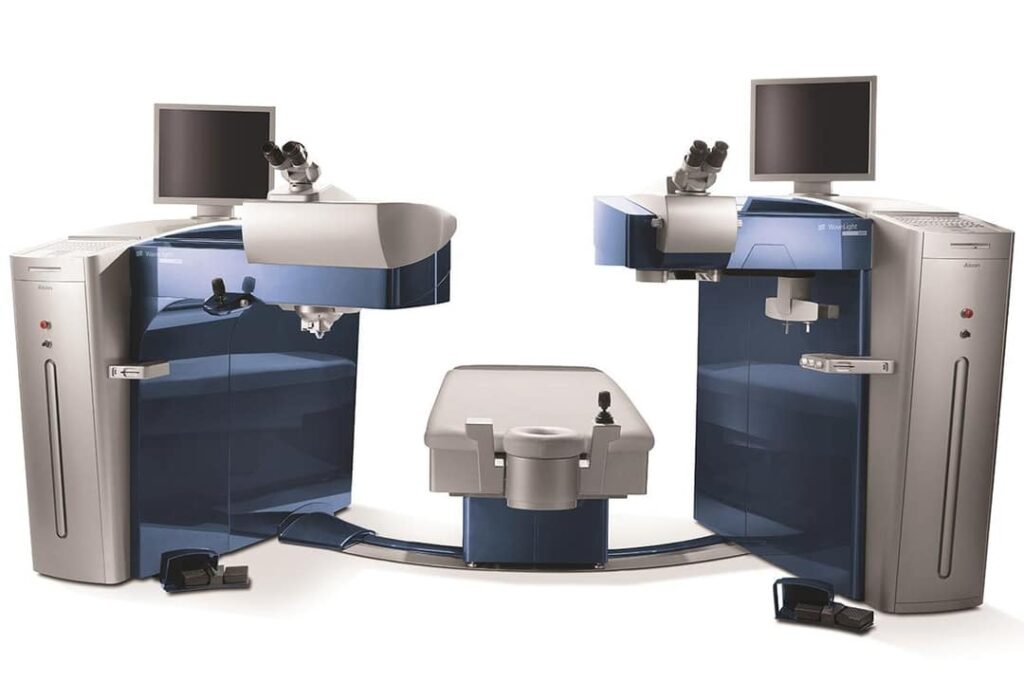
LASIK, which stands for Laser In-Situ Keratomileusis, is an extremely popular refractive surgery procedure used to correct myopia (nearsightedness), hyperopia (farsightedness), and astigmatism.
It’s so popular, in fact, that we’ve performed the surgery for over 10,000 patients.
We can also use LASIK surgery to treat presbyopia in a procedure known as monovision correction.

Batra Vision has always been on the forefront of LASIK technology. We offer the latest generation of surgical lasers, which now have the advanced capability to make all corneal changes with laser precision. All-Laser LASIK gives our patients the most advanced vision correction procedure available today.
Recently, Batra Vision was the first provider in the United States to perform a commercial LASIK surgery using the Allegretto WaveLight 500 platform. WaveLight is the fastest refractive surgery platform available in the U.S. Its innovative engineering helps reduce the potential for stromal dehydration of the cornea, flap shrinkage, sensitivity to eye movements, and patient fixation fatigue.
Below, you will find information on LASIK surgery using Wavefront™ and IntraLase® technology, Epi- LASIK, and PRK. You will also find a set of general pre-op and post-op instructions we give each of our LASIK patients. If you would like to learn more about laser vision correction or would like to schedule a consultation at our East Bay and Berkeley area offices to discuss LASIK surgery, contact Batra Vision Medical Group today.
Wavefront™ technology, a LASIK option available at our East Bay area offices, allows a refractive surgeon to generate an extremely accurate map of a patient’s eye. This specially generated map helps identify the unique aberrations (imperfections) that affect an individual patient’s vision. The information from this Wavefront™ map is electronically transferred to a computer that precisely controls the laser during surgery.
With Wavefront™, patients can expect high quality results following LASIK surgery. For instance, many patients report that contrast is better defined following Wavefront™-guided LASIK. Wavefront™ patients often experience better vision at night and in poor lighting than regular LASIK patients. Additionally, patients with thin corneas who were unable to undergo standard LASIK may still qualify for Wavefront™-guided LASIK. Recovery time from Wavefront™-guided LASIK surgery may also be more rapid than standard LASIK.
This iBook* addresses questions and concerns that patients often have when considering Laser Vision Correction. The iBook also provides a closer look at LASIK procedures with the WaveLight® EX500 Excimer Laser and the WaveLight® FS200 Femtosecond Laser.
Epi- LASIK, which stands for Epithelial Laser In-Situ Keratomileusis, is a refractive surgery procedure performed on patients who may not be ideal candidates for standard LASIK surgery due to thin corneas or other eye conditions. During Epi- LASIK, the epithelium, the thin outer layer of the cornea, is lifted without the use of a cutting instrument. The rest of the procedure is performed like standard LASIK in which the cornea is reshaped using a laser. While the recovery period following Epi- LASIK tends to be longer than with standard LASIK surgery, the results are still the same.
Monovision refers to a refractive surgery practice in which one eye is corrected to view distant objects while the other is corrected to view nearby objects. Monovision correction is a common procedure for the treatment of presbyopia, an age-related condition in which the lens of the eye loses its flexibility and hence its ability to focus properly. If presbyopia is affecting your vision, we can help determine if monovision correction or another ophthalmology treatment such as lens implant surgery is best for correcting your vision.
Epi- LASIK, which stands for Epithelial Laser In-Situ Keratomileusis, is a refractive surgery procedure performed on patients who may not be ideal candidates for standard LASIK surgery due to thin corneas or other eye conditions. During Epi- LASIK, the epithelium, the thin outer layer of the cornea, is lifted without the use of a cutting instrument. The rest of the procedure is performed like standard LASIK in which the cornea is reshaped using a laser. While the recovery period following Epi- LASIK tends to be longer than with standard LASIK surgery, the results are still the same.
PRK, which stands for Photorefractive Keratectomy, is another alternative to LASIK surgery that is generally performed on patients with stable vision and low to moderate refractive errors. Unlike traditional LASIK in which a flap is created in the cornea, during PRK, the epithelium, the thin outer layer of the cornea, is removed. The cornea is then reshaped using a laser as in LASIK surgery. The recovery period following PRK is longer and generally less comfortable than standard LASIK since the epithelium must regenerate. Once the patient has recovered, the results of PRK are generally the same as LASIK.
Below are general pre-op and post-op instructions for patients visiting our San Leandro, Concord, Oakland, and East Bay area offices for LASIK, Epi- LASIK, or PRK. You will receive a similar set of instructions that includes important reminder dates and detailed eye drop instructions prior to your refractive procedure.

The best way to find out if LASIK is right for you is to schedule a consultation at our offices in San Leandro and Berkeley. During your visit, we will determine if you are a good candidate for LASIK and help you decide which refractive procedure or ophthalmic treatment is best for you. To schedule a consultation in the East Bay and Oakland area for LASIK surgery, contact Batra Vision Medical Group today.
LASIK surgery is a quick and virtually painless refractive procedure performed on an outpatient basis. The procedure involves the creation of a thin flap on the cornea (the front of the eye) using either a precise instrument called a microkeratome or a surgical laser. This corneal flap is folded back allowing a refractive surgeon to reshape the cornea using a refractive laser. Once the cornea has been reshaped, the corneal flap is folded back into its original position where it will heal naturally without the need for sutures or stitches. LASIK surgery takes only a few minutes to perform per eye.
The final results of LASIK surgery will vary from patient to patient given the unique nature of each patient’s eyes. Current statistics show that LASIK success rates can be as high as 98 percent, with patients achieving vision of 20/20 or better without the aid of glasses or contact lenses.